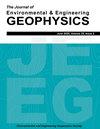隧道近场螺纹震源的多维反褶积
IF 0.7
4区 工程技术
Q4 ENGINEERING, GEOLOGICAL
引用次数: 0
摘要
在地下隧道建设中,可采用带式输送机或地铁列车作为被动震源,对周围地层进行时移地震评价。被动地震过程的关键技术是地震干涉测量技术(SI),它能够提取感兴趣介质中任意两点之间的格林函数。然而,由于工艺结果通常需要满足一定的前提假设,目前的SI方法不能直接用于带式输送机。在目前的研究中,这种类型的源被称为近场螺纹源,所提出的新的SI方法适用于这种类型的源。主要有两种SI方法:互相关SI和多维反褶积SI。前者要求无源源在远场均匀分布,后者放宽了均匀分布的要求,但仍需要远场源。当第一个假设被违反时,相关函数与具有模糊源的格林函数成正比。然后通过所谓的干涉点扩展函数对源模糊进行量化,该函数可以从观测数据中导出。因此,通过MDD使用SI可以通过对PSF进行反卷积来有效地消除Green函数源的模糊。在本研究中,一组检波器作为被动震源位于一个隧道中,另一组检波器位于相邻隧道中。然而,由于设置几乎与无源源的分布一致,PSF的空间(波数)频谱太宽而无法反转。因此,传统的MDD方法不适合本研究的实验。本研究发现,可以从邻近隧道的数据中获得另一个PSF。在此基础上推导了新的MDD公式,并与传统MDD公式的推导过程进行了比较。然后,通过数值仿真验证了该方法的可行性。本文章由计算机程序翻译,如有差异,请以英文原文为准。
Multi-Dimensional Deconvolution for Near-Field Thread Seismic Sources in Tunnels
In underground tunnel constructions, belt conveyors or subway trains can be used as passive sources for time-lapse seismic assessments of surrounding formations. The key technology of passive seismic processes is seismic interferometry (SI), which has the ability to extract the Green's function between any two points in a medium of interest. However, since the process results are typically required to meet certain premise assumptions, the current SI methods cannot be directly used for belt conveyors. In the current study, this type of source is referred to as a near-field thread source and the proposed new SI method is adapted to this type of source. There are mainly two types of SI methods: SI by cross-correlation and SI by multi-dimensional deconvolution. The former requires that the passive source be uniformly distributed in the far field, while the latter relaxes the requirements for uniform distribution yet still requires far field sources. When the first assumptions are violated, the correlation function is proportional to a Green's function with a blurred source. The source blurring is then quantified by what is referred to as an interferometric point-spread function, which can be derived from the observed data. Therefore, using SI by MDD can effectively deblur the source of the Green's function by deconvolving the PSF. In this study, one set of geophones is located in one tunnel as the passive source, and another set is in an adjacent tunnel. However, since the setup almost coincided with the distribution of the passive sources, the spatial (wavenumber) spectrum of the PSF is too broad to be inverted. Therefore, a conventional MDD method is not suitable for this study's experiments. This study found that another PSF could be obtained from the data of the adjacent tunnel. Subsequently, a new MDD formula based on the new PSF is derived and compared with the derivation processes of the conventional MDD formula. Then, the feasibility of the proposed method is verified using numerical simulations.
求助全文
通过发布文献求助,成功后即可免费获取论文全文。
去求助
来源期刊

Journal of Environmental and Engineering Geophysics
地学-地球化学与地球物理
CiteScore
2.70
自引率
0.00%
发文量
13
审稿时长
6 months
期刊介绍:
The JEEG (ISSN 1083-1363) is the peer-reviewed journal of the Environmental and Engineering Geophysical Society (EEGS). JEEG welcomes manuscripts on new developments in near-surface geophysics applied to environmental, engineering, and mining issues, as well as novel near-surface geophysics case histories and descriptions of new hardware aimed at the near-surface geophysics community.
 求助内容:
求助内容: 应助结果提醒方式:
应助结果提醒方式:


